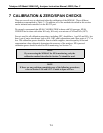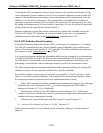
Teledyne API Model 200AU NO
X
Analyzer Instruction Manual, 02293, Rev. F
7-9
Table 7-8: Z/S Valves Modes with Remote Contact Closure
Ext Zero CC Ext Span CC Operation
Contact Open Contact Open State when in SAMPLE mode, normal monitoring.
Contact Open Contact Closed Span check or calibrate
*
Contact Closed Contact Open Zero check or calibrate
*
* Calibrate only if Dynamic Calibration is enabled.
7.6 EPA Protocol Calibration
If the M200AU is to be used for EPA compliance monitoring, it must be calibrated in accordance
with the instructions in this section.
In order to insure that high quality, accurate measurements are obtained at all times, the
M200AU must be calibrated prior to use. A quality assurance program centered on this aspect
and including attention to the built-in warning features of the M200AU, periodic inspection,
regular zero/span checks and routine maintenance is paramount to achieving this.
In order to have a better understanding of the factors involved in assuring continuous and
reliable information from the M200AU, it is strongly recommended that Publication No. PB 273-
518 Quality Assurance Handbook for Air Pollution Measurement Systems (abbreviated, Q.A.
Handbook) be purchased from the NTIS (phone 703-487-4650). Special attention should be paid
to Section 2.3 which deals with chemiluminescent based NO
2
analyzers and upon which most of
this section is based. Specific regulations regarding the use and operation of ambient oxides of
nitrogen analyzers can be found in 40 CFR 50 and 40 CFR 58. Both publications are available
from the U.S. Government Printing Office (phone 202-783-3238).
7.6.1 Calibration of Equipment
In general, calibration is the process of adjusting the gain and offset of the M200AU against
some recognized standard. The reliability and usefulness of all data derived from any analyzer
depends primarily upon its state of calibration. In this section the term dynamic calibration is
used to express a multipoint check against known standards and involves introducing gas
samples of known concentration into the instrument in order to adjust the instrument to a
predetermined sensitivity and to produce a calibration relationship. This relationship is derived
from the instrumental response to successive samples of different known concentrations. As a
minimum, three reference points and a zero point are recommended to define this relationship.
The true values of the calibration gas must be traceable to NIST-SRM's (Section 2.0.7, Q.A.
Handbook).


















